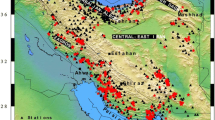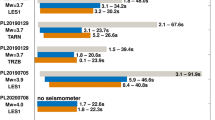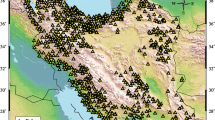Abstract
We explore the use of high-rate GPS, strong-motion records and their joint use for earthquake monitoring, the data collected during 2011 Mw 9.0 Tohoku earthquake was studied. We compared the recorded co-seismic movement, analyzed the displacements in both time-frequency domain. Meanwhile, the comparison of P wave detection was shown and the dynamic velocity waves were discussed. The results suggest that the GPS-only solution is good for low-frequency signal, and the strong-motion-only solution is good for high-frequency signal, thus, the integration of two datasets best complement the advantages of each, more details of co-seismic motions and broader frequency band of seismic signals. This is crucial for earthquake monitoring and early warning.







Similar content being viewed by others
References
Aoi S, Kunugi T, Fujiwara H (2004) Strong-motion seismograph network operated by NIED: K-NET and KiK-Net. J Jpn Assoc Earthq Eng 4:65–74
Bilich A, Cassidy JF, Larson KM (2008) GPS seismology: Application to the 2002 Mw 7.9 Denali Fault earthquake. Bull Seismol Soc Am 98:593–606
Bock Y, Prawirodirdjo L (2004) Detection of arbitrarily large dynamic ground motions with a dense high-rate GPS networks. Geophys Res Lett 31:L06604. doi:10.1029/2003GL019150
Bock Y, Melgar D, Crowell BW (2011) Real-time strong-motion broadband displacements from collocated GPS and accelerometers. Bull Seismol Soc Am 101:2904–2925
Boore DM (2001) Effect of baseline corrections on displacement and response spectra for several recordings of the 1999 Chi-Chi, Taiwan, earthquake. Bull Seismol Soc Am 91:1199–1211
Boore DM, Stephens CD, Joyner WB (2002) Comments on baseline correction of digital strong-motion data: Examples from the 1999 Hector Mine, California, earthquake. Bull Seismol Soc Am 92:1543–1560
Chao W, Wu Y, Zhao L (2009) An automatic scheme for baseline correction of strong-motion records in coseismic deformation determination. J Seismol 14:495–504
Chen J, Larson KM, Tan Y, Hudnut KW, Choi K (2004) Slip history of the 2003 San Simeon earthquake constrained by combining 1-Hz GPS, strong motion, and teleseismic data. Geophys Res Lett 31:L17608. doi:x10.1029/2004GL020448
Colosimo G, Crespi M, Mazzoni A (2011) Real-time GPS seismology with a stand-alone receiver: A preliminary feasibility demonstration. J Geophys Res 116:B11302. doi:10.1029/2010JB007941
Elósegui P, Davis JL, Oberlander D, Baena R, Ekströ G (2006) Accuracy of high-rate GPS for seismology. Geophys Res Lett 33:L11308. doi:10.1029/2006GL026065
Geng J, Bock Y, Melgar D, Crowell BW, Haase S (2013) A new seismogeodetic approach applied to GPS and accelerometer observations of the 2011 Brawly seismic swarm: Implications for earthquake early warning. Geochem Geophys Geosyst. doi:10.1002/ggge.20144
Graizer VM (1979) Determination of the true ground displacement by using strong motion records Izv. Earth Phys 25:26–29
Irwan M, Kimata F, Hirahara K, Sagiya T, Yamagiwa A (2011) Measuring ground deformations with 1-Hz GPS data: the 2003 Tokachi-oki earthquake (preliminary report). Earth Planets Space 56:389–393
Iwan W, Moser M, Peng C (1985) Some observations on strong motion earthquake measurement using a digital acceleration. Bull Seismol Soc Am 75:1225–1246
Langbein J, Bock Y (2004) High-rate real-time GPS network at Parkfield: utility for detecting faults slip and seismic displacements. Geophys Res Lett 31(15)L15S20. doi:10.1029/2003GL019408
Larson KM (2009) GPS seismology. J Geod 83:227–233. doi:10.1007/s00190-008-0233-x
Larson KM, Bodin P, Gomberg J (2003) Using 1-Hz GPS data to measure deformations caused by the Denali fault earthquake. Science 300:1421–1424
Li X, Ge M, Zhang Y, Wang R, Klotz J, Wicket J (2013a) High-rate coseismic displacements from tightly-integrated processing of raw GPS and accelerometer data. Geophys J Int 195:612–624
Li XX, Ge MR, Zhang XH, et al. (2013b) Real-time high-rate co-seismic displacement from ambiguity-fixed precise point positioning: Application to earthquake early warning. Geophys Res Lett 40. doi:10.1002/grl.50138
Li XX, Ge MR, Zhang Y, et al. (2013c) New approach for earthquake/tsunami monitoring using dense GPS networks. Sci Rep 3:2682. doi:10.1038/srep02682
Lou YD, Zhang WX, Shi C, Liu JN (2014) High-rate (1-Hz and 50-Hz) GPS seismology: Application to the 2013 Mw 6.6 Lushan earthquake. J Asian Earth Sci 79:426–431
Melgar D, Bock Y, Sanchez D, Crowell BW (2013) On robust and reliable automated baseline corrections for strong motion seismology. J Geophys Res. doi:10.1002/jgrb.50135
Miyazaki S, Larson KM, Choi K, et al. (2004) Modeling the rupture process of the 2003 September 25 Tokachi-Oki (Hokkaido) earthquake using 1-Hz GPS data. Geophys Res Lett 31:L21603. doi:10.1029/2004GL021457
Picozzi M, Parolai S, Mucciarelli M, Milkereit C, Bindi D, Ditommaso R, Vona M, Gallipoli MR, Zschau J (2011) Interferometric analysis of strong ground motion for structural health monitoring: the example of the L’Aquila, Italy, seismic sequence of 2009. Bull Seismol Soc Am 101:635–651. doi:10.1785/0120100070
Smalley R (2009) High-rate GPS: how high do we need to go? Seis Res Lett 80(6)1054–1061. doi:10.1785/gssrl.80.6.1054
Tu R, Wang R, Ge M, Walter TR, Ramatschi M, Milkereit C, Bindi D, Dahm T (2013a) Cost effective monitoring of ground motion related to earthquakes, landslides or volcanic activities by joint use of a single-frequency GPS and a MEMS accelerometer. Geophys Res Lett. doi:10.1002/grl.50653
Tu R, Ge M, Wang R, Walter TR (2013b) A new algorithm for tight integration of real-time GPS and strong-motion records, demonstrated on simulated, experimental, and real seismic data. J Seismol. doi:10.1007/s10950-013-9408-x
Tu R, Wang R, Zhang Y, Walter TR (2014) Application of a net-based baseline correction scheme to strong-motion records of the 2011 Mw 9.0 Tohoku earthquake. Geophys J Int. doi:10.1093/gji/ggu092
Wang R, Schurr B, Milkereit C, Shao Z, Jin M (2011) An improved automatic scheme for empirical baseline correction of digital strong-motion records. Bull Seismol Soc Am 101:2029–2044
Wang R, Parolai S, Ge M, Jin MP, Walter TR, Zschau J (2013) The 2011 Mw 9.0 Tohoku earthquake: comparison of GPS and strong-motion data. Bull Seism Soc Am. doi:10.1785/0120110264
Wu Y, Wu C (2007) Approximate recovery of coseismic deformation from Taiwan strong-motion records. J Seismol 11:159–170
Zhang XH, Guo F, Guo BF, et al. (2012) Coseismic displacement monitoring and wave picking with high-frequency GPS. Chin J Geophys 55(6):1912–1918
Zumberge JF, Heflin MB, Jefferson DC, Watkins M (1997) Precise point positioning for the efficient and robust analysis of GPS data from large networks. J Geophys Res 102:5005–5017
Acknowledgments
The work was partly supported by the program of National Natural Science Foundation of China (Grant No:41504006) and Chinese Academy of Sciences (CAS) programs of “Pioneer Hundred Talents”, “Light of West China” and “Youth Innovation Promotion Association”.
Author information
Authors and Affiliations
Corresponding author
Rights and permissions
About this article
Cite this article
Tu, R., Zhang, P., Zhang, R. et al. Comparison of high-rate GPS, strong-motion records and their joint use for earthquake monitoring: a case study of the 2011 Mw 9.0 Tohoku earthquake. Arab J Geosci 9, 542 (2016). https://doi.org/10.1007/s12517-016-2570-z
Received:
Accepted:
Published:
DOI: https://doi.org/10.1007/s12517-016-2570-z




